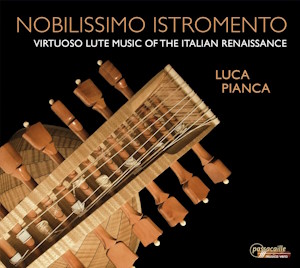
Nobilissimo Instrumento
Virtuoso Lute Music of the Italian Renaissance
Luca Pianca (lute)
rec. 2020, Santa Maria Assunta, Villa Luganese, Lugano, Switzerland
Reviewed as a digital download
Passacaille PAS1107 [70]
The less-trodden byways of music can often be the most exciting to explore. Neither performer nor label was known to me prior to this review, nor am I well acquainted with lute music of any period, or the Italian Renaissance composers whose work is recorded here. To begin with the artist, Swiss-born Luca Pianca is not only the co-founder of the successful early music ensemble, Il Giardino Armonico, but also a celebrated lutenist specializing in the arch-lute. He studied with Nicolas Harnoncourt, and has won many prestigious awards for his recordings. His recital here includes several composers of the period, but focuses primarily on the career of Canova Da Milano (1497-1543), ‘Il Divino’.
Canova was lutenist at royal courts, as well as three successive papal courts, one of the most influential of the period. His works are brief, heartfelt and to my ears, quite beguiling. The forms Canova favoured were the ricercar and fantasia, of which he wrote more than a hundred. His compositions mark the transition from an improvisatory style to a more refined and organized polyphony. In particular, Canova manipulates and develops short motifs within a narrative outline, just as his contemporary Josquin des Prez was doing in the world of vocal music. The works recorded here well convey the nobility of the lute, as expressed in the album’s title.
With regard to the recording itself, the airy acoustic of the beautiful late medieval church of Santa Maria Assunta creates a front-of-stage intimacy which is well suited to such a recital. The programme commences with Canova’s Fantasia 65, which sets the tone with subtle changes of pace and mood. The following piece, Fantasia 30, is more measured and formal but just as lovely. Canone a 2 is faster, lighter, almost mandolin-like. Fantasia 34 ‘La Compagna’ is one of Canova’s best known pieces. It alternates dance-like figurations with a melancholic falling theme. Jakob Lindberg’s recording of the same piece on BIS 2202, is of similar length to Pianca, but rather less intense and with a more subdued soundworld. Paul O’Dette on Harmonia Mundi (HMU907557) is closer to Luca Pianca in both recorded sound and overall feeling.
Aside from Canova, this recording also presents works by his contemporaries and pupils. Of these, only Da Crema was previously known to me. Little is known about Giovanni Maria da Crema’s life, but his Libro Primo was one of the most interesting lute works of the period, and showed the influence of Canova. Some pieces are even credited to the latter in other sources. A selection of da Crema’s works for lute, as well as those of Canova da Milano, have been recorded on Brilliant Classics by Domenico Cerasani, playing an eight course lute. I find the sound in that recording to be boxier and less spacious, but it certainly offers an intriguing contrast, and which you prefer will be a question of personal taste.
The jointly attributed work ‘De mon triste desplaisir’ has been recorded by Caius Hera, whose pleasing album of music by Canova can be found on YouTube or purchased by contacting the artist directly.
Given the current vogue for contemplative piano works, it strikes me that the lute works of this period will potentially appeal to many listeners. Their sense of calm and stillness offers a rewarding listening experience, particularly when well-played and recorded as here. I have enjoyed the bright, very forward acoustic and church reverb employed by Pianca, but others may prefer the more low-key, gentler recording by Jakob Lindberg.
Passacaille is a Belgian label; their CDs are attractively presented with informative notes. I have already begun to investigate the other lute works in their catalogue.
As an irrelevant but amusing aside, Canova da Milano, was the subject of a musical hoax by one Vladimir Vasilov who passed off one of his own compositions as being by him. A version by rock band, Aquarium subsequently became a huge hit in the Soviet Union!
Keith Brumpton
Buying this recording via a link below generates revenue for MWI, which helps the site remain free



Contents
Francesco Canova da Milano (1497-1543)
Fantasia 65
Fantasia (30)
Giovanni Maria da Crema (fl.1540-1550)
Recercar secondo
Claudin de Sermisy (c. 1490-1562)/Canova da Milano
La je m’y plains
Vincenzo Capirola (1474 – after 1548)
Recercar alla spagnola
Francesco Canova da Milano
Canone a 2
Perino Fiorentino (F1523-1552)
Fantasia Prima
Francesco Canova da Milano
Fantasia 7
Francesco Bendusi (b?-died c. 1553)
Incognito
Francesco Canova da Milano
Fantasia 33
Jean Richafort (c. 1480-c. 1547)/Canova da Milano
De mon triste deplaisir
Vincenzo Capirola
Recercar nono
Francesco Canova da Milano
Fantasia 1
Giulio Cesare Barbetta (c. 1540; d. after 1603)
Fantasia septima
Francesco Canova da Milano
Fantasia 15
Fantasia 34 “La Compagna”
Orazio Vecchi (1550-1605)
So be mi ch’a bon tempo
Francesco Canova da Milano
Fantasia 87
Fantasia 10
Giovanni Maria da Crema
Recercar decimoquinto
Francesco Canova da Milano
Fantasia 61
Guilio Segni da Modena (1498-1561)
Fantasia ottava
Francesco Canova da Milano
Fantasia 90
Vincenzo Capirola
Recercar sesto
Francesco Canova da Milano
Fantasia 6
Antonio Rotta (1495-1549)
Fantasia 67
Francesco Canova da Milano
Fantasia 5
Joan Ambrosio Dalza (fl. 1508)
Calata spagnola
Francesco Canova da Milano
Fantasia 22

















